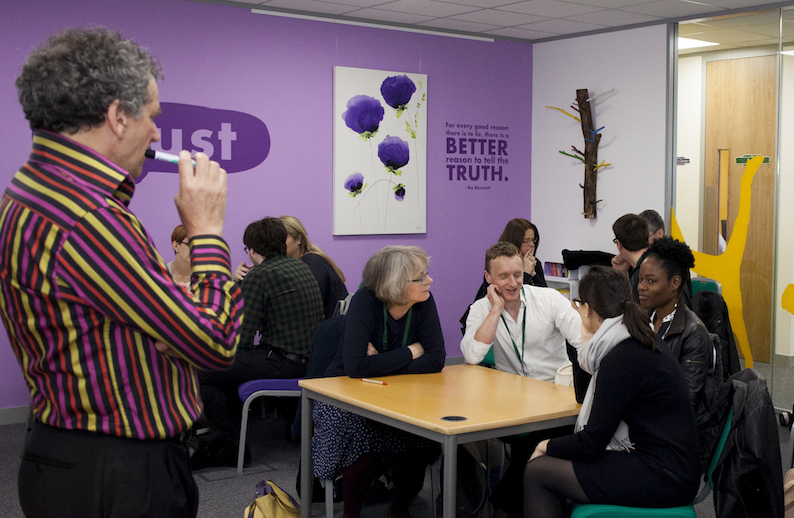 There are many similarities between facilitation in a face to face setting and facilitation in an online setting.
There are many similarities between facilitation in a face to face setting and facilitation in an online setting.
Both types of facilitation need to follow the central principles of facilitation, as talked about in our previous post on facilitation as a key skill for learning and development.
However, there are quite a few major differences as well and those differences need to be approached carefully. Let’s look at those differences.
One of the biggest differences between analogue and digital facilitation is the where and when. Facilitated face-to-face learning takes place in the same location and in real time. We often call this synchronous learning.
If you move synchronous learning online, you have webinars and other live facilitated learning sessions, on platforms like Adobe Connect or even Skype. Learners can connect in real-time, from different locations. The skills of face-to-face facilitation still apply and are transferrable to online synchronous learning, but there are also differences to be aware of, which we will touch on later.
If you then remove the 'in real time' element, you have asynchronous learning. Noddlepod is an example of a collaborative platform for asynchronous learning. The learning is self-paced, with participants logging onto the platform and engaging with the learning at times that suit them.
While synchronous learning typically happens in defined chunks, with events that start and stops, asynchronous learning is a more fluid, continual process.
 The ability to dip in and out of learning significantly elongates the whole learning and facilitation process. Learners meet continuously, even if not simultaneously. Facilitated learning tends to work to less of an agenda than other types of learning anyway, but this is accentuated online. With online facilitated learning, it can be much easier and is more common for users to build upon and rekindle a discussion that has already been aired. Whether it’s the facilitator or someone else in the group breathing new life into the debate, the conversation can be informed by the previous discussion.
The ability to dip in and out of learning significantly elongates the whole learning and facilitation process. Learners meet continuously, even if not simultaneously. Facilitated learning tends to work to less of an agenda than other types of learning anyway, but this is accentuated online. With online facilitated learning, it can be much easier and is more common for users to build upon and rekindle a discussion that has already been aired. Whether it’s the facilitator or someone else in the group breathing new life into the debate, the conversation can be informed by the previous discussion.
On digital platforms, the interaction is often recorded automatically by the technology being used. Both the official content and the informal interaction can be accessed whenever and wherever. We often think of convenience with regards to this - learners accessing content on their phone when commuting - but the real value is as much to do with timelines. What do we mean by this? The permanence of online interaction allows learners to find or revisit content as it becomes relevant and timely for their own individual learning journey. Participants can rekindle discussions, ask questions and share their reflections in a social space - each time building on the curated knowledge of the community. This is a really big benefit.
Group dynamics are different in analogue facilitation and digital facilitation. With face to face learning, facilitated or otherwise, a lot of communication is not said, but is implied and picked up. Facial expressions, body language, tone of voice….these communication cues are hugely important, for the facilitator and for the group. Without them, it is very easy for communications to be misinterpreted and for nuances to be lost.
Technology can be a communication barrier, even when using an immediate medium such as Skype, but that is a barrier that can and should be easily surmounted.
 Digital learning has long been seen primarily as an alternative to analogue learning and as a way to cut costs and classroom time. Thankfully, the conversation is changing to how digital can support and enrich what happens face-to-face and how to use the skills and role of the facilitator online to allow for more personalised learning journeys.
Digital learning has long been seen primarily as an alternative to analogue learning and as a way to cut costs and classroom time. Thankfully, the conversation is changing to how digital can support and enrich what happens face-to-face and how to use the skills and role of the facilitator online to allow for more personalised learning journeys.
But the differences between the digital and the analog have been off putting for many experienced face to face facilitators.
Facilitators fear that digital facilitation is less effective and that their own skills won’t translate very well. Understandably, it can be daunting. However, a skilled and experienced face to face facilitator should make a skilled and then experienced digital facilitator. The skills and methods of the facilitator are transferrable; they just need some re-work and fine-tuning.
-------
This is the second blog posts series on the topic of facilitation. Stay tuned for practical steps on how to take your facilitation skills online and build valuable communities of social learning and mutual support.
First photo taken of facilitator and Noddlepod partner Henry Stewart. Credit: Gabriel Stewart
Find out more on how you can use Noddlepod as a group facilitation tool.